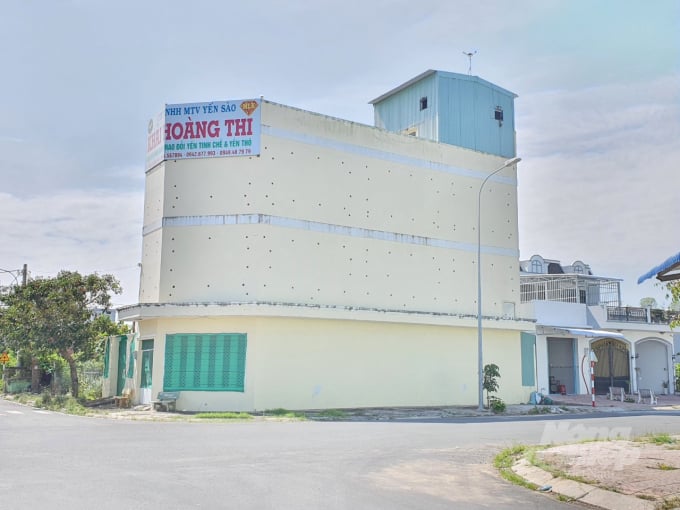November 26, 2025 | 10:33 GMT +7
November 26, 2025 | 10:33 GMT +7
Hotline: 0913.378.918
November 26, 2025 | 10:33 GMT +7
Hotline: 0913.378.918
Firstly, the local administration has yet to issue a plan to zone a specific area to raise swiftlets in the province.
Therefore, the majority of growers have raised swiftlets spontaneously. They often repair their houses or hotels to raise the swiftlets.
Secondly, local growers are believed to not know well about regulations on raising swiftlets, causing difficulties in the management of local authority as well as many annoyances for people living surrounding the area where the birds are raised.
In the meantime, raising swiftlets, which not only creates noise but also causes environmental pollution and diseases, has become a popular career in recent years in the province.
Because it is the career bringing high income for local growers.
The profession of attracting and raising swiftlets is not only concentrated in coastal areas, urban areas but also in rural areas and residential areas in the province’s Bac Lieu City, including the residential area of the Ward 2, the residential area of the Ward 5, Trang An residential area and Hoang Phat residential area.

Noise from swiftlet farming has affected many households in residential areas in the province of Bac Lieu. Photo: Trong Linh.
Le Huu Van, Deputy Director of Trang An Investment and Consulting Co Ltd said according to statistics in the Trang An residential area, there are 14 households farming swiftlets so far.
There are many households that broadcast loudspeakers to attract the swiftlets all the day and night, with a large frequency, causing many inconveniences to neighbouring households in the residential area, he said.
"Although the company has repeatedly disseminated and encouraged the households to make adjustment of the time and sound to attract the swiftlets but failed," he said.
Nguyen Duy Hung, Head of the province’s Livestock and Veterinary Medicine Division, said that the locality has yet to issue an area for raising swiftlets.
However, the regulations on the area for raising swiftlets has been approved by the members of the Provincial People's Committee and is expected to be issued by the provincial People's Council early next year, he said.
Currently, there are regulations on sound intensity and time to play loudspeakers to attract swiftlets, but the deal with violations is still facing difficulties because growers have yet to know well about the regulations.
The division plans to work with local authorities to strengthen dissemination and inspection to deal with violations in the coming time to improve the management of raising swiftlets in the province.
Swiftlets have been bred in 42 out of 63 provinces and cities with a total of about 20,000 swiftlet houses, of which Kien Giang province is the largest home to swiftlet with about 2,600 houses.
Viet Nam’s swiftlet-farming output is about 120 tonnes, equivalent to US$450 million in value. Currently, bird's nest products in Viet Nam are mainly exported by local companies, earning about US$100-125 million per year.
Viet Nam's swiftlet-farming has started since 2010, mainly in southern provinces and cities, putting out about 3 per cent of global bird’s nest production.
In general, many people in Asia believe that bird’s nest has various nutritional and medicinal benefits. It is used in traditional medicines for immunity, lung health, and to enhance recovery from ailments. Many also use bird’s nest for its associated beauty and anti-aging properties.
Altogether, there are approximately 96 known species of swiftlets, of which approximately 30 of the species residing within Southeast Asia and Northeastern Australia. All swiftlets belong to the Apodiform order and the Apodidae family.
Swiftlets can be found living in many different habitats but all have one key criteria that there should be a water body nearby. Another key criterion is that, since the birds are foraging insectivores, there should be sufficient food, meaning large numbers of flying insects, in the vicinity. /
Translated by Thu Hang
/2025/11/25/0045-1-135246_13.jpg)
(VAN) Ca Mau is researching a model of sea-encroaching embankments combined with viaducts and logistics service zones, aiming both to prevent erosion and create land funds for marine economic development.

(VAN) The information was shared at the seminar 'Urban Agriculture - Solutions for Developing Green Spaces,' organized by the Kinh te & Do thi Newspaper and the Biotechnology Center of Ho Chi Minh City.
/2025/11/19/4141-2-132831_216.jpg)
(VAN) One of Japfa's outstanding solutions is implementing digital transformation and artificial intelligence (AI) to optimize operations, enhance productivity, and advance sustainable development.
/2025/11/19/4847-1-093540_448.jpg)
(VAN) The Gia Lai Provincial People’s Committee had a working session with the delegation of the U.S. Department of Agriculture, the State of Idaho, and representatives of the State's leading enterprises.

(VAN) Ca Mau has a sufficient foundation to become a strong regional aquaculture center, where production integrates the economy, the environment, and the lives of the people.

(VAN) SEIKI Group envisions itself as a pioneer in the ‘dual transformation’ of digital technology and green industry, standing alongside the Government and Vietnamese businesses in their pursuit of sustainable development.

(VAN) The VNGEONET network affirms Viet Nam's progress in mastering digital space, providing a precise positioning data platform to serve socioeconomic development.